Eagle Guide
by Martin Willey and Marcus Lindroos
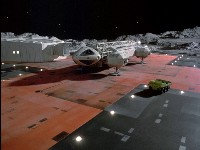
The Eagle models were built in four scales, the largest being 43.25 inches/ 1.1m long. Inside the command module are two astronauts from Revell's 1:24 Gemini kit; they also fit the 5 inch Moonbuggy sometimes seen alongside the Eagle on the launch pad. The Eagle hangar furniture, including steps to the Eagle door, are also 1:24 scale. This would make the Eagle 26.4m long (about 87 feet).
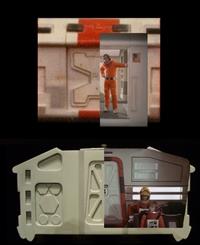
This photo (from The Exiles) has been resized to fit inside the passenger module which would be 4.75m (15.66 feet) wide. Although the end door indeed is the correct size, Keith Wilson's passenger module set is too wide to fit inside. The passenger module can only accommodate the height of the 2.38m / 7.8 feet set if the floor is lowered, which means it will no longer be at the same level as that of the front access corridor or cockpit. At 1:24 scale, the Eagle side door is about 1.5m / 5ft tall, and the access corridor interior ceilings would be less than 1.8m / 5.8 feet tall. The length of the cockpit interior set will also have to be reduced to fit inside the 1:24 scale Eagle.
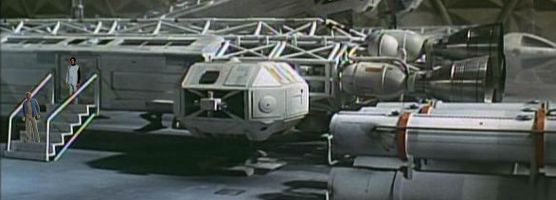
Roberto Baldassari's more practical scale is 1:28, making the Eagle 102 feet/ 31m long (see below). As Martin Daoust's collage shows, this makes the hangar steps very steep- each step is about 40cm/ 16 inches high!

The full width of the studio passenger module set was about 5.5m / 18 feet. The resulting length of the Eagle would then be 100 feet, i.e. essentially 1:28 scale. As this montage shows, the visible exterior of the studio set (from Black Sun) does fit very well although the side door is wider on the outside. The passenger module end doors are however much smaller on the inside than on the outside. Image thanks to David Sisson, composite by Marcus Lindroos
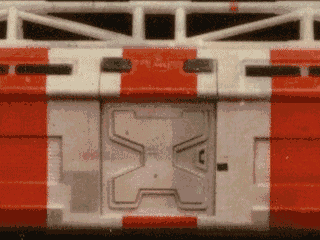
As shown in this animation, the inconsistency between the SFX model and studio set can be resolved by assuming the side hatch in fact consists separate outer and inner doors!
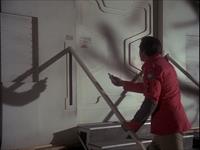
The floor of the passenger module is 2.4m / 8ft above the ground, but the studio version appears to be about 0.9m / 3ft above ground. On Seed Of Destruction Tony and Maya have a short single step down to the surface, as if the Eagle has sunk into the ground.
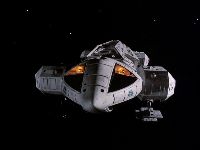
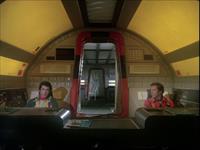
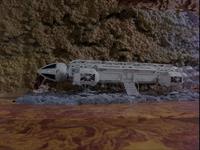
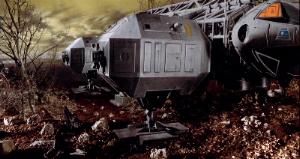
The Another Time, Another Place shot of an Eagle with crew reveals another problem: the cockpit seen through the windows is much higher than the passenger module. When the pilots are seated, their eyeline would be in the centre of the Eagle; to see them from outside we would have to look down. Looking closely at the background set behind the pilots shows how most of the height of the cabin has gone.
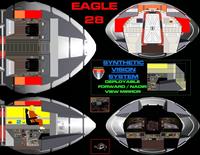
The diagram above depicts a possible cockpit configuration within the confines of the 1:28 scale Eagle. To maintain consistency between Keith Wilson's set and the SFX model, the height of the pilot seats must be adjustable by over two metres! The pilots occasionally pull back the yellow cockpit ceiling panels and then raise the seats to access the top windows when making e.g. navigational observations in deep space. However, the normal position of the seats is just above the floor and behind the main console. The top windows are never actually used for landing as they would be largely useless of this purpose anyway (the pilots would have no downward visibility whatsoever). To be able to actually see the ground during take-off and landing, the seated pilots instead have to rely on a synthetic vision system (probably prism or fibre optic periscope based) located in front of the main console. The area above and directly behind the normal position of the seats on the floor is sealed off by a wall, marked red in the diagram. The wall behind the astronauts must be as wide as possible to accommodate the ventilation grills. As previously mentioned a second far aft wall (marked orange) is glimpsed in Another Time, Another Place and The Testament of Arkadia. The ceiling must be the same height as the forward windows, and the aft wall must be as far away as possible or else the door will be offset with respect to the Eagle centre line.
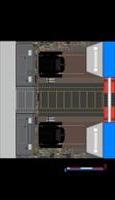
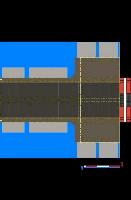
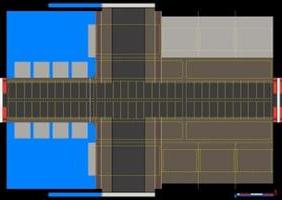
In Year 2, the Eagle set is 9.6m / 32 ft long, losing the 2.4m / 8ft forward corridor section. This creates a serious continuity problem with the exterior design, but the long corridor was rarely used. Its loss is not immediately obvious on screen, apart from there being only one set of doors between the pilot section and the passenger section. A better solution, proposed by Martin Daoust, may have been to turn the passenger module round, putting the seats in the front half. To save studio space, the module corridor, now in the rear, could have been closed off with a door.
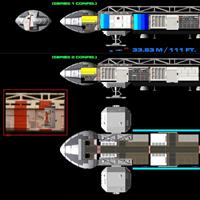
Keith Young's "Moonbase Alpha Technical Manual" assumes the Eagle is 33.8m / 111ft long. It is the only design large enough to accommodate the full studio cockpit set (now located entirely below the windows). It also copes with the entire Year 2 Eagle set redesign better than the others: simply add two passenger pod sets end-to-end! In year 2 the aft door was always closed, and the forward-facing doors are open only in The Beta Cloud. The access tunnel between cockpit and passenger module is not wide enough to accommodate the side doors but it does not matter, since these parts are never visible from the cockpit anyway. Note that the Series 2 passenger module cannot undock from the rest of the Eagle (the last module separation occurred in Year 1's Dragon's Domain). Unfortunately, as shown in the insert, the Eagle will now also be much bigger than the Eagle side door.
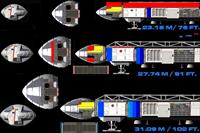
Scale comparison between (from top to bottom) Geoffrey Mandel's, Phil Rae's and Roberto Baldassari's Eagles, with Keith Wilson's studio set (from The Last Sunset) superimposed on top. Red denotes areas where there is not enough room for the studio set while blue denotes empty or "wasted" space as the set is smaller than the Eagle SFX model. Mandel's 76 ft. Eagle obviously lacks the ceiling space to accommodate the set. Rae's 91 ft. Eagle largely avoids this problem except for the front part of the cockpit. Overall, Baldassari's 102 ft. Eagle design maintains good consistency with the exterior dimensions of the studio set and it achieves perhaps the best trade-off (see comparison matrix at the end of this page).
| Blueprint artist | Length ft | Length m |
|---|---|---|
| Roberto Baldassari | 102 | 31 |
| Leslie Everhart | 150 | 46 |
| Geoffrey Mandel | 76 | 23 |
| Phil Rae | 91 | 28 |
| Keith Young | 111 | 34 |
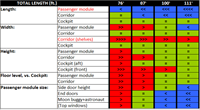
There is no "perfect" Eagle scale as the matrix above demonstrates. The length of the passenger pod set as well as the width of the aft (i.e. shelf) end of the corridor will always be inconsistent with the SFX model. Geoffrey Mandel's 76ft. Eagle better matches the length of the set than the other versions, but is otherwise much too small, as denoted by the red cells. The 100 to 102 ft. Eagle represents the best overall trade-off as it closely matches the external width and height of the studio set while minimising the inevitable errors (for example, it is still roughly small enough to match the 1/24 scale moon buggy and astronaut). However, the 87-91ft. Eagle and Keith Young's 111ft. version can also be made to work almost equally well.
Copyright Martin Willey. Thanks to Roberto Baldassari, Marcus Lindroos.